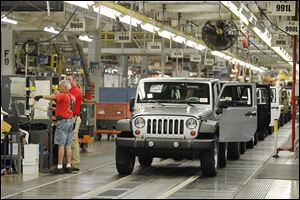
Aluminum weighed for future Wranglers
Lighter vehicle considered in 5-year plan
5/8/2014
Jeep Wranglers roll off the assembly line at the Chrysler Toledo Assembly Complex. Fiat Chrysler Chief Executive Sergio Marchionne hinted that aluminum could be used to make future Wranglers.
AUBURN HILLS, Mich. — The next-generation Jeep Wrangler could make use of aluminum to cut weight, though leaders at Fiat Chrysler Automobiles aren’t keen on the metal for their upcoming Ram pickups — at least not yet.
“I have better use for aluminum ... than in the pickup truck,” Chief Executive Sergio Marchionne said at the company’s investor day Tuesday at Chrysler headquarters. “I think we actually have better mileage today than the alleged mileage of the aluminum truck from Ford by using diesel.”
Chrysler introduced a 3.0-liter diesel V-6 earlier this year for its Ram 1500, giving the truck up to 28 miles per gallon on the highway. Right now, the best Ford F-150 gets 23 mpg highway. However, Ram’s diesel starts at several thousand dollars more than Ford, and Ford hasn’t publicly said what kind of mileage it expects out of its upcoming aluminum model.
In any case, Mr. Marchionne is taking a wait-and-see approach, even though he said the company could do an aluminum truck in 2017.
“Ford is a big, big player in pickups and I respect their judgment, and that’s why I told you we’re going to hold off and see what happens in the marketplace,” he said. “If necessary we’ll emulate them.”
What’s he waiting for? Perhaps the Wrangler, which is built in Toledo.
Asked if there was any better use for aluminum in the company’s lineup than Wrangler, a vehicle the company needs to take weight out of but can’t risk making soft, the ever chatty executive had a simple answer.
“No,” he said.
The next new Wrangler is due in 2017. Whether the company actually uses aluminum instead of steel for any of the SUV’s body panels or structure remains to be seen. But it was just one of many clues that point toward what will drive the company’s offerings five years from now.
Beyond a strategy to solidify brand identity, a lot of what’s coming will focus on improving Chrysler’s fleet fuel economy, one of the industry’s worst.
First off, expect a lot more gears.
As of 2013, the company’s most-used transmission was a six-speed automatic. Fast forward five years, and Fiat Chrysler says 52 percent of its vehicles sold in North America will have a nine-speed automatic transmission, up from just 3 percent last year. An additional 33 percent will come with an eight-speed automatic, up from 19 percent last year.
Manual transmissions will stick around but continue to make up a tiny portion of all cars sold.
While the number of gear ratios is going up, the number of cylinders is coming down.
By 2018, FCA says almost half — 48 percent — of vehicles sold in North America will be powered by a four-cylinder engine. Last year, four-cylinders made up 27 percent of the market for the company.
The company is investing $2 billion to develop a new line of small gasoline engines that will go into production next year.
Still, Bob Lee, Chrysler’s powertrain head, said powerful V-8s aren’t going away.
“These engines will have a place in our portfolio in 2018,” he said.
In spite of the addition of a diesel option for the Jeep Grand Cherokee and Ram, Mr. Lee doesn’t forecast any significant market share increase for diesel from 2013 to 2018.
Chrysler Group will get its first plug-in hybrid in 2016 in the next generation of the Chrysler minivan. Mr. Lee said that vehicle should be able to get 75 mpg, though he admitted it was a “regulatory driven” move and not something customers are necessarily demanding.
Mr. Lee said the van is a good fit for a hybrid powertrain because there is space to put batteries without affecting passengers.
A second plug-in hybrid from Chrysler will follow in 2017, as well as what company officials characterized as some other mild hybrids.
Though FCA’s presenters didn’t focus on start-stop technology, Mr. Marchionne is clearly on board.
“Start-stop now is a way of life,” he said. “Subject to customer rejection, which is a big issue, stop-start is something that is going to become pretty well standard for a variety of reasons.”
Start-stop technology automatically shuts off the engine when the vehicle isn’t moving and restarts it when the driver releases the brake.
Contact Tyrel Linkhorn at tlinkhorn@theblade.com or 419-724-6134 or on Twitter @BladeAutoWriter.